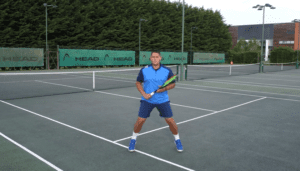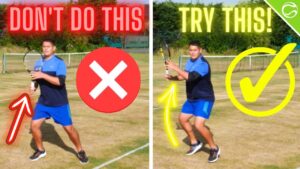
How To Hit The Perfect Inside-Out Forehand in Tennis
How To Hit The Perfect Inside-Out Forehand in Tennis
Being able to dominate baseline rallies with your forehand will help you win many points in tennis. In order to do this successfully, you’ll need to be able to attack with your inside-out forehand.
What Is an Inside-Out Forehand in Tennis?
An inside-out forehand is when you move around your backhand to hit a reverse forehand, and hit the shot crosscourt into a right-handers backhand side. An inside-in forehand would be a down the line shot hit from the same position, going into a right-handers forehand.
Why Use an Inside-Out Forehand in Tennis?
There are two main reasons to use an inside-out forehand in tennis:
- To control the point with your strength, which is the forehand for the vast majority of tennis players, by hitting into most opponent’s weakness, which is the backhand.
- To attack higher bouncing balls on the backhand side of the court which is difficult to attack with a one-handed or two-handed backhand. The forehand offers more range of motion and we can deal with shoulder or head height balls much easier with that stroke.
When To Use an Inside-Out Forehand in Tennis?
You have to pick the right moment to run around your backhand and hit the inside-out forehand in tennis, one of the best times to do so is when you’ve been trading backhands crosscourt with your opponent and you get a slightly slower ball or a ball that comes more to the middle of the court and you have the opportunity to get around the ball in time.
A shorter ball on the backhand side is also a good time to hit an inside-out forehand.
How To Hit an Inside-Out Forehand in 3 Steps:
- Step One – Get into the correct position and set up with your body.
As soon as you decide to hit an inside-out forehand, the first few steps will be crucial to help you get around the ball. By using a cross-behind step as your first step, you’ll cover a good amount of distance with just one step, but you’ll also have the freedom in the hips to coil the upper body and set up with your racket. If you use sidesteps or crossover steps, you can still get around the ball if you have very fast feet but you won’t get as much coil with the body during the movement phase. - Step Two – Using the correct stance. When you are first learning the inside-out forehand, the neutral stance is the easiest way to get power, direction, and your body-weight moving through the shot.
As you progress, you can also use the open stance forehand or the semi-open stance forehand. Whichever stance you use, try to get your body weight going into the shot, following the line of the ball. - Step Three – Tactical intentions. By running around your backhand to hit the inside-out forehand, you are creating opportunities for yourself, however, you are also exposing a large amount of court for your opponent to exploit. That’s why it’s vital that you know what you’re trying to do with the shot, and you anticipate your opponent making the ball.
Deep Crosscourt – You can hit your inside-out forehand with aggressive topspin, with good net clearance, and aim deep into the backhand corner. If you execute this shot well, it should force your opponent to move back, behind the baseline, to deal with a high bouncing ball on their backhand wing.
This can then set you up with an easier shot on the next ball which you can then punish.
Other Variations Of Inside-Out Forehand in Tennis:
- Short Crosscourt – You can also use the width of the court and hit a short angle with your inside-out forehand. This works best when you have more time to set up and when you have a slightly shorter ball. Be aware that when you choose this option, if you don’t execute it properly, your opponent can attack you down the line and expose your space there with their backhand.
- Approach Shot – On a shorter ball, or when you can really step in and get your body weight moving through the inside-out forehand, you can also choose to follow the ball and attack the net. When you choose this option, make sure you get across the court quickly and cover the down the line pass.



